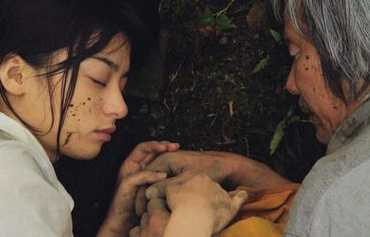Jugu
Abraham is a film critic
at Dear Cinema.
He gave The Mourning Forest, which played at Montreal's
2008 Festival
Nouveau Cinema, 3 out of 4 stars. For the ratings
for the entire festival, click
HERE.
There
are directors who write their own original stories and scripts
and those who bring to the screen works of novelists, playwrights,
and even biographers and historians. The directors who develop
their own scripts are not just good filmmakers but arguably
potential novelists or playwrights.
 One
such formidable director is Japan’s Naomi Kawase. Her
films win awards at prestigious film festivals after which
she churns out well received novels in Japanese that are based
on her original film-scripts.
One
such formidable director is Japan’s Naomi Kawase. Her
films win awards at prestigious film festivals after which
she churns out well received novels in Japanese that are based
on her original film-scripts.
Prior to playing at Montreal’s 2008 Nouveau Cinema Festival,
The Mourning Forest won the Grand Jury Prize at the
2007 Cannes Film Festival.
The Mourning Forest (Mogari no mori) centers around
a somewhat senile 70-year-old man, Shigeki, who is living
in an old age home in Japan, in a situation not unlike Sarah
Polley’s Canadian film Away from Home. Shigeki,
played by Yoichiro Saito, is cared for by a young woman, Machiko,
a new nursing recruit. Her name, which is similar to Shigeki
‘s wife’s name, Mako, who died 33 years before,
triggers a passion in him to visit her grave in the forest.
And thus begins a quixotic pilgrimage to the grave in a perilous
journey that will unlock man’s mystical relationship
with nature.
On
the 33rd anniversary, according to Japanese Buddhist beliefs,
the departed must travel to the land of Buddha, somewhat like
the Roman Catholic Christian belief of the dead reaching heaven
/hell after a stay in purgatory. The couple will have to part
forever unless he bids farewell soon before the anniversary.
The
Mourning Forest can be divided into two parts.
The
first part introduces the viewer to the two main characters:
the nurse and the nursed. Both have suffered personal loss
and are grieving. The nurse, Machiko, has lost a child for
which her husband holds her responsible. The nursed (the old
man) has lost his wife and evidently never remarried and keeps
writing letters to his dead wife that must be “delivered.”
The nurse dominates the first part. We view the two figures
chasing each other between rows of tea bushes, their heads
clearly visible over the verdant green landscape. There is
warmth of the sun. There is an allusion to life.
 The
second part inverses the earlier situation with the action
taking place within the forest (a literal and figurative forest).
The nursed dominates the nurse. The nursed tricks the smart
young woman as he trudges to his wife’s grave. Whether
the spot is really her grave or not is of little consequence
since the act of undertaking the pilgrimage is what matters
as he has to deliver his letters to his wife before 33 years
of her death are completed. In contrast to the tea plantation
scenes, the forest towers over the human figures Instead of
sun, there is cold, darkness and mystical overflowing streams
that threaten hypothermia as well as allusions to death and
regeneration.
The
second part inverses the earlier situation with the action
taking place within the forest (a literal and figurative forest).
The nursed dominates the nurse. The nursed tricks the smart
young woman as he trudges to his wife’s grave. Whether
the spot is really her grave or not is of little consequence
since the act of undertaking the pilgrimage is what matters
as he has to deliver his letters to his wife before 33 years
of her death are completed. In contrast to the tea plantation
scenes, the forest towers over the human figures Instead of
sun, there is cold, darkness and mystical overflowing streams
that threaten hypothermia as well as allusions to death and
regeneration.
As
Kawase explains, “After the two enter the forest, the
forest becomes the force that supports them. It watches over
the two of them, sometimes gently, sometimes more strictly.”
The
film's title roughly translates into “Forest of Mogari,”
and at the end of the film the director states the meaning
of the term “mogari.” Mogari means “the
time or act of mourning.”
Unlike
Away From Her, the Japanese film dwells on understanding
the richer complexities of life and death. “Running
water never returns to its source,” says the old man
Shigeki to his nurse, words of solace for a young woman to
look afresh at her marriage after losing a child.
Kawase
states that the fate of her cognitively declining grandmother
inspired the making of the film. “Such people are looked
down somewhat, and pitied, forgetting that it could happen
to us someday.” Through her film, she hopes viewers
will learn kindness and a new way of handling difficulties,
which she says can help people around the world overcome religious
and cultural differences. The nurse strips off her clothes
to provide warmth to her ward and protect him from hypothermia,
a gesture that must seem unusual to Western sensibilities.
There is no sex here; mere practical help in time of need.
There are streams that suddenly flood as if they have a life
of their own and emerge as characters in the film.
Kawase
has made a rich film using her own story. In treading in the
footsteps of directors Terrence Mallick, Carlos Reygadas and
Andrei Tarkovsky, the forest is transformed into a metaphor
of memories and traditions, and eventually becomes a source
of eternal strength. Kawase represents the finest in contemporary
Japanese cinema today, blending nature and tradition in storytelling.